Are you looking for the best Duolingo alternatives? Yes? Here are some of the best alternatives to Duolingo for language learning.
Learning a new language is a transformative experience with various benefits that extend far beyond simply being able to communicate with more people. It’s a skill that can positively impact your cognitive abilities, career prospects, and personal life.
In the past decade, language learning has completely transformed. There was a time when you had to rely solely on expensive tutors, heavy grammar books, or classroom-based lessons.
Nowadays, it’s possible to learn new languages from home. All you need is a smartphone and an internet connection, and you can start learning a new language from anywhere in the world.
Many language learning apps and platforms have emerged over the years. One of the most popular apps is Duolingo.
In this post, we’ll explore some of the best Duolingo alternatives, breaking down their strengths, weaknesses, pricing, and ideal use cases.
Table of Contents
What is Duolingo?
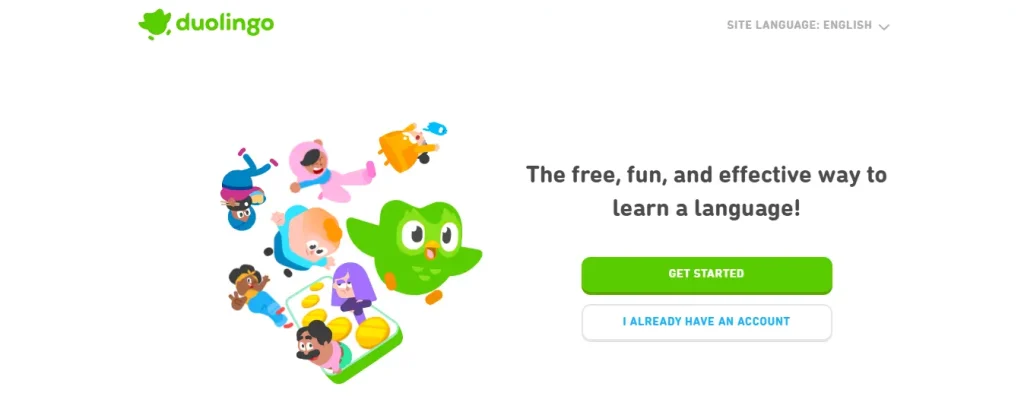
Duolingo is a language learning app that supports over 40 languages. It is a popular, free platform that uses a gamified approach to teach users new languages, as well as other subjects like math, music, and chess.
Duolingo exploded in popularity for one simple reason: it made learning languages fun and free. The app uses gamification—points, streaks, badges, and colorful animations—to turn studying into a game.
Here are some key reasons behind Duolingo’s popularity:
- Accessibility: It’s available for free, with optional premium features.
- User-Friendly Design: It’s known for its simple interface that makes learning easy for anyone.
- Gamified Motivation: Daily streaks and leaderboards encourage learners to come back.
- Variety of Languages: It supports over 40 languages, from Spanish and French to more unique options like Welsh, Swahili, or Hawaiian.
- Micro-Lessons: The lessons are short and interactive, allowing users to learn in small, manageable chunks.
It’s no wonder Duolingo is the best language learning app for beginners. However, its limitations become obvious as you progress.
The Limitations of Duolingo
Duolingo is effective to learn new languages. However, it’s often recommended as a foundational or supplementary tool rather than a complete path to fluency on its own.
Duolingo alone is not sufficient to achieve true fluency in a language. Here are some key limitations of Duolingo:
- Limited Conversational Practice: Duolingo’s exercises are heavily based on translation and repetition of isolated, and often nonsensical, sentences. This format is not suitable for developing speaking skills.
- Lack of Depth: Language is deeply intertwined with culture and real-world context. Duolingo often teaches phrases in a vacuum, without explaining the social cues or slang that are essential for appropriate communication.
- Minimal Grammar Explanation: It often doesn’t provide clear, explicit explanations of grammatical rules. This can be frustrating for learners to understand why a language works the way it does.
- A One-Size-Fits-All Approach: Lessons are the same for all learners. The app’s design dictates what you learn. You can’t choose a specific topic or focus on a particular skill (e.g., listening or speaking) you want to improve. Moreover, the repetitive nature of the exercises can become monotonous and may not hold the attention of serious learners over the long term.
- Business Model and Monetization: The free version of the app uses a “hearts” system that limits the number of mistakes you can make per lesson. Moreover, users must subscribe to a premium plan to remove ads, get unlimited hearts, and access offline lessons.
Duolingo is a great language learning app for beginners. As you can see, it has some limitations. You might want to try Duolingo alternatives to overcome these limitations.
Key Features to Look for in a Language Learning App
Not all language learning apps are created equal. Some focus on vocabulary memorization, others emphasize grammar, while a few prioritize conversation and real-life communication.
When selecting a language learning app, it’s essential to consider a few features that cater to different learning styles and goals. The most effective language learning apps are those that go beyond simple vocabulary flashcards and offer a comprehensive, engaging, and personalized experience.
1. A Comprehensive and Structured Curriculum
The language learning app should have a clear and logical curriculum that builds on foundational knowledge. Lessons should be organized thematically (e.g., greetings, food, travel) to help you acquire practical, real-world skills.
A good language learning app provides a balance of vocabulary building and grammar explanations. Simply memorizing words isn’t enough when it comes to communication. The app should teach you how to use them properly in sentences.
Some language learning apps include audio to hear words pronounced by native speakers, visuals to see them written, and interactive exercises (such as tapping, typing, and speaking) to reinforce learning. It helps language learners practice and learn a language more effectively.
2. Interactive and Engaging Activities
Gamification provides features like points, levels, leaderboards, and “streaks,” which can turn learning into a fun and motivating game. This method is helpful for beginners.
The language learning app should offer a variety of interactive exercises beyond simple flashcards. These can include:
- Matching games
- Fill-in-the-blank questions
- Stories or dialogues with comprehension checks
- Drag-and-drop activities
Some apps use AI-powered chatbots to simulate real conversations, allowing you to practice speaking and receive immediate feedback without the pressure of a real-life conversation.
3. Tools for Speaking and Listening
Some language learning apps have speaking and listening tools like speech recognition, audio from native speakers, and immersive content.
- Speech Recognition: This feature helps language learners practice pronunciation. This technology listens to you speak, analyzes your pronunciation, and provides instant corrective feedback.
- Audio from Native Speakers: High-quality audio recordings from native speakers help you to develop an accurate accent and improve your listening comprehension.
- Immersive Content: Content like short stories, audio dramas, or video clips (e.g., from TV shows or commercials) helps you learn the language in a natural context.
4. Personalization
A good language learning app uses algorithms to analyze your performance and tailor the lessons to your specific needs. This ensures you’re always challenged at the right level and not overwhelmed.
Moreover, some apps come with the Spaced Repetition System (SRS), which is a proven method for memorization. This feature will schedule reviews of vocabulary and concepts at optimal intervals, so you review them just before you’re about to forget them.
5. Accessibility
The ability to download lessons for offline use is a valuable feature. This is crucial for learning on the go or in areas with poor internet connectivity.
Moreover, the app should be accessible on various devices (smartphone, tablet, web) and sync your progress seamlessly.
6. Pricing and Subscription Models
Most language learning apps follow a “freemium” model—basic features for free, advanced tools for paid subscribers.
It’s not necessary to upgrade to the paid plan. Only commit to a paid plan if you need advanced features. Otherwise, stick with the free plan.
The Best Duolingo Alternatives
There are many Duolingo alternatives, each with its own strengths and weaknesses. The best language learning app will depend on your learning style, goals, and the language you want to learn.
Let’s look at some of the best Duolingo alternatives to learn new languages.
1. Babbel
- Pricing: Free, Single Language ($19.95/mo), All Languages ($17.95/mo), Lifetime ($299.50)
- Accessibility: Web, iOS, and Android
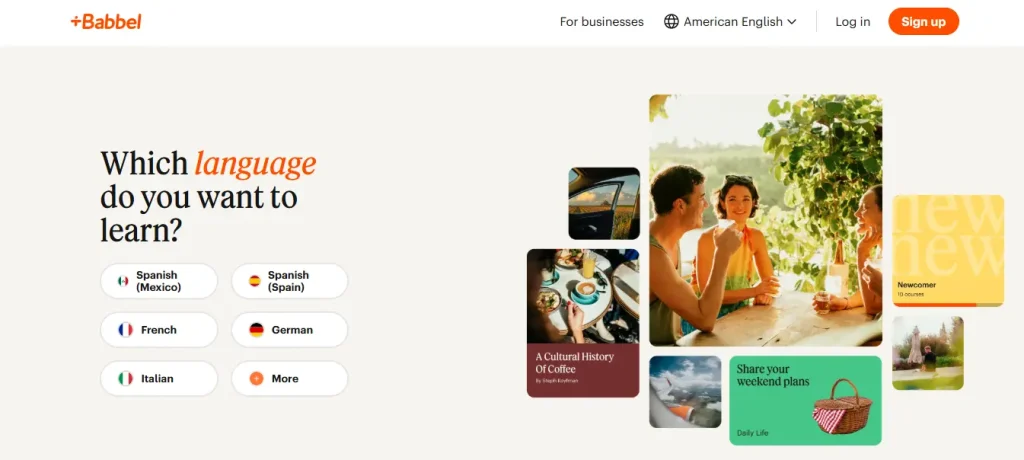
Babbel is a subscription-based language learning platform, known for its structured, curriculum-based approach to teaching languages.
Unlike Duolingo, which focuses heavily on repetition and gamification, Babbel focuses on practical, conversational skills. Moreover, Babbel’s lessons are created by 200+ language experts.
The platform offers courses in 14 languages, including Spanish, French, German, Italian, Portuguese, Russian, Danish, Dutch, Indonesian, Norwegian, Polish, Swedish, and Turkish. Moreover, it offers courses at beginner, intermediate, and advanced levels.
Babbel designed its lessons to be short and interactive, typically taking 10-15 minutes to complete, which makes them easy to fit into a busy schedule.
It has a speech recognition feature to sharpen your pronunciation. You can build your conversation skills with engaging, interactive dialogues.
Pros:
- It focuses on practical conversation that emphasizes teaching useful words and phrases.
- It has clear and integrated grammar explanations.
- The courses are developed by a team of linguistic experts, ensuring the material is high-quality, accurate, and structured for effective learning.
- It tailors its courses to your native language.
- The platform is suitable for beginners, intermediate, and advanced levels.
Cons:
- Limited access with the free plan.
- Limited language selection compared to the main competitors like Duolingo.
2. LingoDeer
- Pricing: Free, Monthly ($14.99), Lifetime ($199.99)
- Accessibility: Web, iOS, and Android
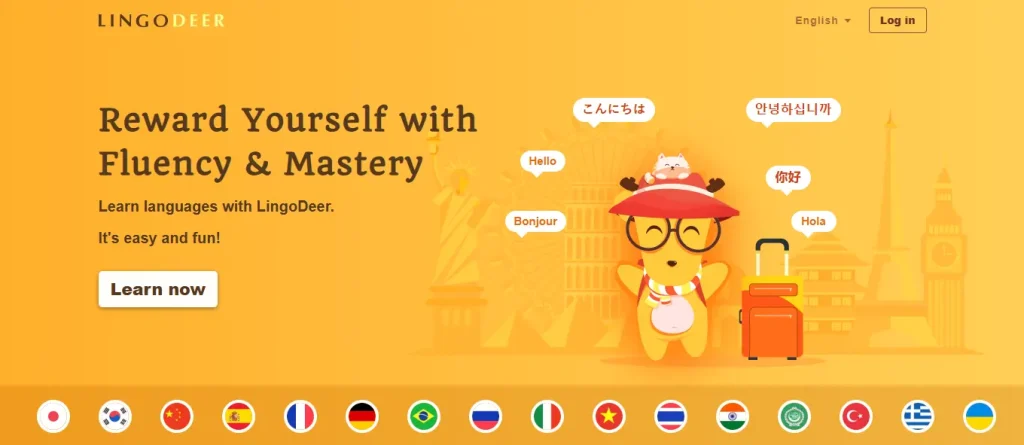
LingoDeer is another language learning app and platform that is well-known for its focus on Asian languages like Japanese, Korean, and Mandarin Chinese. However, it has expanded to European languages like German, Italian, and French.
LingoDeer is often compared to apps like Duolingo, but with a more structured, grammar-focused approach. Unlike Duolingo, it provides clear, detailed “Learning Tips” that explain grammar rules and sentence structure.
LingoDeer’s courses are developed by language teachers and are well-organized, building from beginner to intermediate levels. It uses high-quality audio recordings from native speakers for all of its lessons.
Pros:
- It includes a variety of interactive exercises that cover vocabulary, grammar, reading, and listening.
- With a premium subscription, you can download lessons and learn offline.
- It has a user-friendly interface.
- You can practice speaking with hundreds of engaging stories.
Cons:
- Limited for advanced learners.
- It has separate apps for additional features.
3. Busuu
- Pricing: Free + Premium ($12.99/mo)
- Accessibility: Web, iOS, and Android
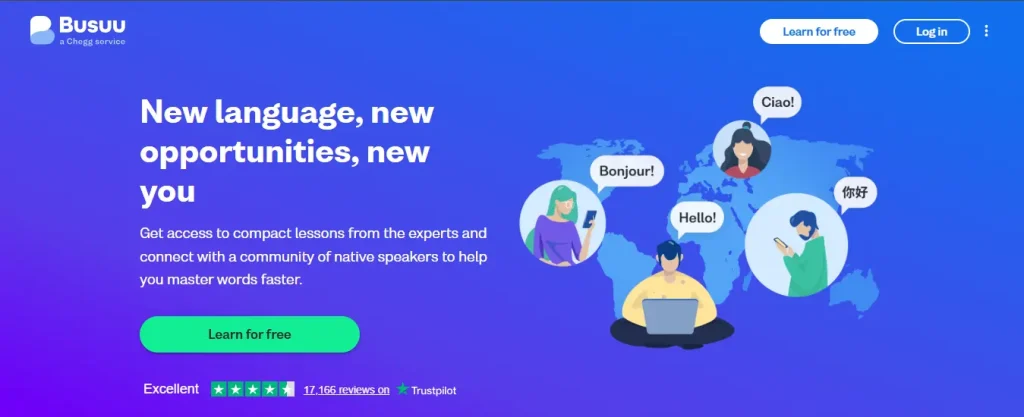
Busuu is another language learning app and platform that helps users learn new languages through interactive lessons and a unique community feature.
You can learn up to 14 languages with the Busuu app, including Spanish, English, German, Italian, and Dutch. The courses are developed by language experts, and each course is structured according to the Common European Framework of Reference (CEFR), an internationally recognised standard for creating language lessons.
It offers a self-study environment with bite-sized lessons that cover the four key language skills: reading, writing, listening, and speaking. The lessons often include: video clips of native speakers, interactive exercises, community feedback, and personalized review sessions.
Pros:
- It’s a community-based service where native speakers help you learn a language.
- The courses are developed by language experts and align with the CEFR standard.
- Bite-sized lessons are great for learners with busy schedules who want to fit in quick study sessions.
- It integrates grammar explanations and exercises into its lessons.
- You can take official language tests from McGraw-Hill Education and receive certificates to demonstrate your proficiency (for a fee).
Cons:
- Limited features in the free version.
- Limited conversational practice.
4. Memrise
- Pricing: Free, Pro ($14.99/mo), Lifetime ($199.99)
- Accessibility: Web, iOS, and Android
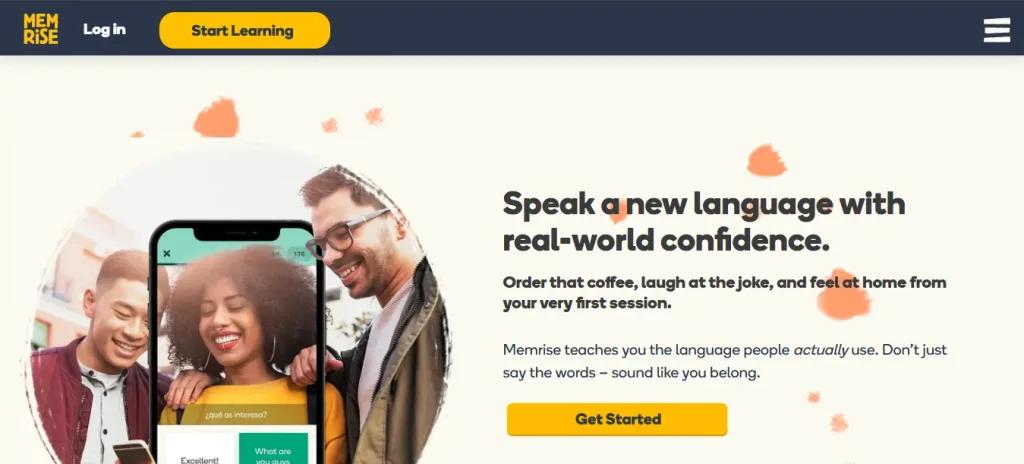
Memrise is an AI-powered language-learning platform and app that uses a combination of spaced repetition, flashcards, and gamification to help users memorize vocabulary and phrases.
It uses spaced repetition system (SRS) that schedules reviews of learned material at increasing intervals to improve long-term retention. Moreover, the platform uses authentic video clips so you hear how locals actually talk.
Memrise has AI-powered tools to help you improve pronunciation without the pressure of a live tutor. AI listens, corrects, and helps you sound more local – at your own pace.
It supports up to 30 languages, including Arabic, Spanish, French, Russian, Italian, Japanese, Korean, Portuguese, Turkish, Dutch, Hebrew, Ukrainian, Swahili, Somali, and Galician.
Pros:
- The spaced repetition system is highly effective for memorizing new words and phrases.
- It has a strong focus on using videos of native speakers.
- It has a large library of user-generated courses.
- The platform incorporates game-like elements, including points, leaderboards, and streaks, to make the learning process more engaging and motivating.
- The free version offers core features and a significant amount of content.
Cons:
- Lack of in-depth grammar explanations.
- Inconsistent quality of user-generated content.
5. LingQ
- Pricing: Free, Premium ($14.99/mo), Premium Plus ($29.99/mo)
- Accessibility: Web, iOS, and Android
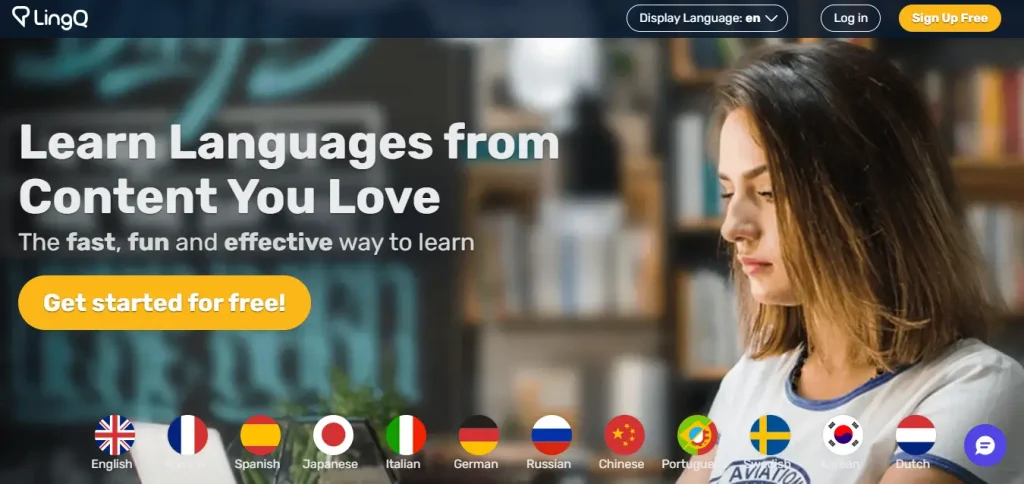
LingQ is another language app and platform that takes a unique approach: it immerses you in authentic content such as articles, podcasts, and videos, allowing you to learn directly from real-world materials.
It supports over 40 languages, including Italian, Chinese, Portuguese, Dutch, Korean, Japanese, Spanish, French, and Hebrew.
The platform focuses on helping users learn language naturally by reading and listening to authentic content they can understand, even if they don’t know every word.
It provides a large library of language courses. However, the most significant feature is the ability for users to import their own content (from websites, YouTube, Netflix, ebooks, etc.) and turn it into interactive lessons.
The Spaced Repetition System (SRS) helps you learn the words that matter to you most. This process of reading, looking up words, and saving them is designed to build vocabulary efficiently and in context.
Pros:
- It uses real-world materials like podcasts, articles, books, and interviews that help you learn the language as it is actually used by native speakers.
- The platform allows you to import your own content and turn it into interactive lessons.
- The synchronized audio and text feature allows you to listen along while you read.
Cons:
- It’s not an ideal option for beginners.
- It does not provide the structured, step-by-step grammar explanations that many learners need, especially at the beginner level.
- Since a lot of the library is user-uploaded, the quality can vary.
6. Drops
- Pricing: Free, Premium ($12.99/mo), Lifetime ($159.99)
- Accessibility: Web, iOS, and Android
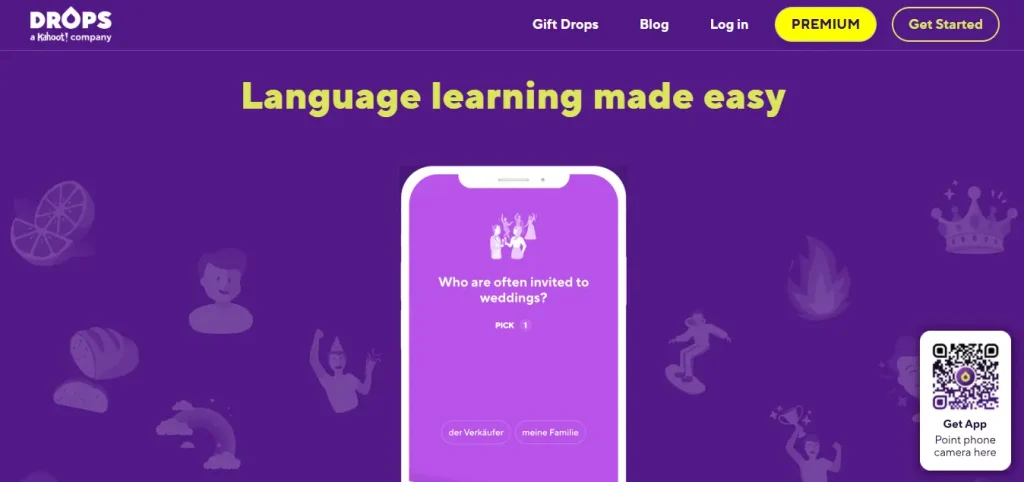
Languagedrops, often called “Drops,” is a language learning app that focuses on vocabulary acquisition through short, visually engaging games. The app is designed to make learning new words a fun and addictive daily habit.
It supports over 50 languages, including Korean, Japanese, English (US), Spanish, Mandarin Chinese, German, Arabic, Hebrew, Russian, Hindi, and Dutch.
It’s one of the best alternatives to Duolingo. However, it stands out from other language apps by its “game-first” approach and its emphasis on connecting words with images rather than direct translation.
It uses gamified exercises, such as “swiping” words to match them with images, or arranging letters to spell a word. This makes learning a new language fun and interactive.
Pros:
- It is highly praised for being visually appealing and for its game-like activities.
- The short, repetitive sessions and visual aids are very effective for memorization.
- It offers a vast library of languages, including many that are not available on other major language learning platforms.
- The app is intuitive and easy to navigate.
- It’s one of the great options for beginners.
- Vocabulary is organized into thematic topics (e.g., food, travel, business).
Cons:
- It does not teach you how to form sentences, understand grammar rules, or engage in conversational practice.
- It provides limited speaking practice.
- The free version is restrictive.
7. Rosetta Stone
- Pricing: Lifetime ($219)
- Accessibility: Web, iOS, and Android

Rosetta Stone is a well-known language learning software that has been around for decades. It uses a proprietary methodology called Dynamic Immersion to teach various languages.
It supports 25 languages, including Spanish, French, Italian, German, Arabic, Chinese, Dutch, Farsi, Irish, Japanese, Tagalog, Turkish, and Vietnamese.
Instead of relying on translation, it immerses the learner in the language from the very beginning, using a combination of images, text, and sound to teach words and grammar through context.
You can achieve fluency faster with Rosetta Stone’s expert-designed Dynamic Immersion courses. Moreover, the TruAccent speech recognition technology helps you sound like a native speaker.
Rosetta Stone takes a “learn like a child” approach, aiming to get you to think directly in the new language. It offers engaging content, such as stories read by native speakers and a Phrasebook, to help prepare for travel.
Pros:
- The “Dynamic Immersion” method forces you to learn new concepts without relying on translation.
- It has a clean, polished, and easy-to-use interface.
- It uses speech recognition technology to provide feedback on your pronunciation.
- Lessons are available on both web browsers and mobile apps.
Cons:
- Lack of grammar explanations.
- Can be repetitive and slow-paced,
- It can be expensive compared to other language apps.
8. Pimsleur
- Pricing: Free Lessons + Premium (Starting at $150)
- Accessibility: Web, iOS, and Android
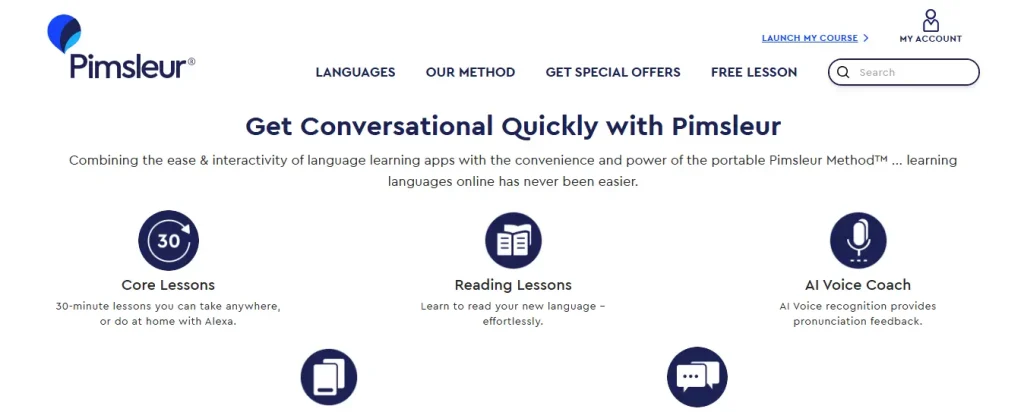
Pimsleur is an audio-based language learning program that focuses on building conversational fluency. This is the perfect language learning solution for people who are always on the go. Its method is based on audio lessons that emphasize listening and speaking.
It supports over 40 languages, including Arabic, Armenian, Czech, Croatian, Farsi, French, German, Hindi, Urdu, Pashto, Russian, and Twi.
The core functionality of this language learning program is its 30-minute lessons, which you can take anywhere or do at home with Alexa.
The AI voice coach feature will provide pronunciation feedback. It will help you sound like native speakers.
Pros:
- Audio-based learning is a major advantage for people with busy schedules.
- Audio-centric design is highly effective for improving pronunciation and aural comprehension.
- It focuses on core vocabulary and real-world scenarios, ensuring that you learn the most practical language first.
- Stay motivated by completing daily challenges.
- Test your conversational knowledge in a fun, fast-paced game.
- Stream live or download and listen offline lessons.
Cons:
- It’s expensive compared to other language learning app.
- It’s not an ideal option for visual learners.
- Limited vocabulary compared to other language learning programs.
9. HelloTalk
- Pricing: Free
- Accessibility: Web, iOS, and Android
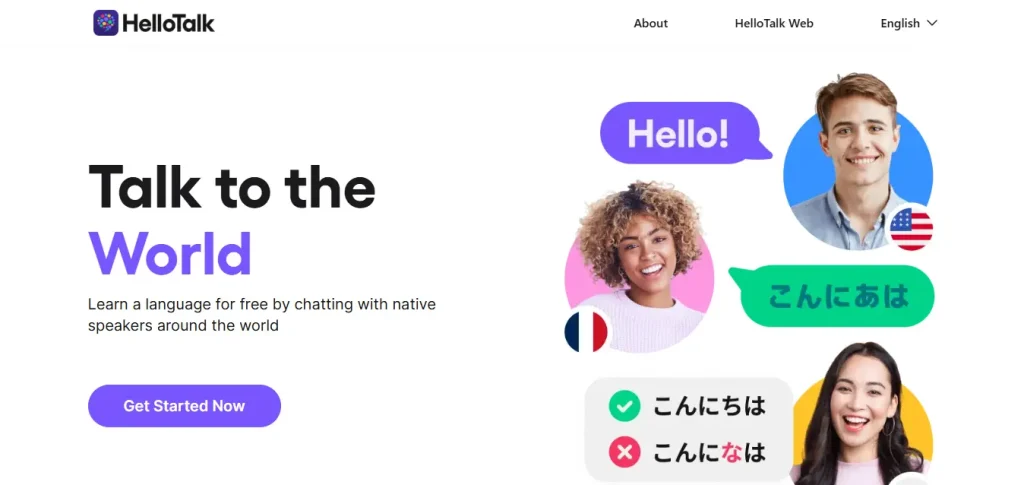
HelloTalk is a free language exchange app that connects language learners with native speakers worldwide. The core functionality of this platform is that native speakers teach you their language, while you teach them yours.
It supports over 180 languages, including English, Chinese, Japanese, Korean, Spanish, French, Russian, Portuguese, German, Italian, and Turkish.
The platform is often described as the social network of language learners. The core of this platform is chat functionality. It has built-in aids for translation, pronunciation, transliteration, and corrections, making conversations run smoothly.
You can meet and chat with locals through text, voice, and video calls, Voicerooms, and Livestreams. Moreover, you can choose the method you’re comfortable with.
Pros:
- It allows you to have authentic, real-time conversations with people who speak your target language.
- It has built-in learning tools, such as translation, corrections, transliteration, and text-to-voice.
- It has millions of users worldwide and supports over 180 languages.
- It’s free to use.
Cons:
- Your learning is highly dependent on the availability and willingness of your language partners.
- It is a practice tool, not a formal language course.
10. italki
- Pricing: Vary (Marketplace)
- Accessibility: Web, iOS, and Android
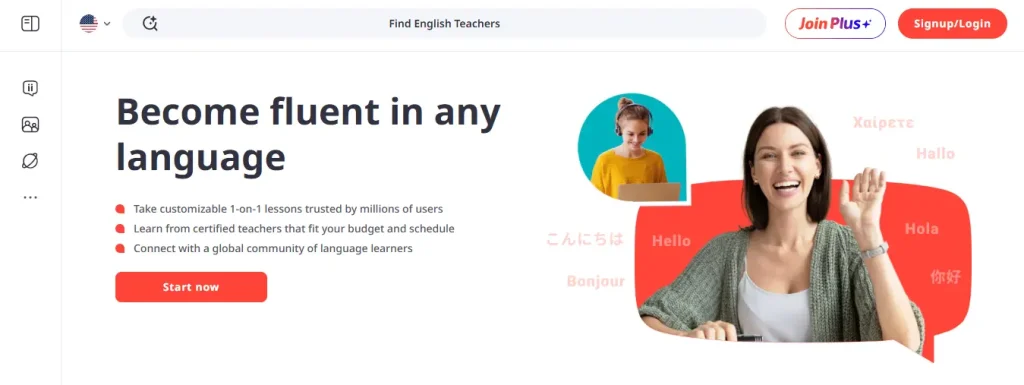
italki is an online language learning platform that connects language learners with professional teachers for one-on-one lessons via video chat.
It’s a language learning marketplace where professional tutors set their own prices and schedules, and students can choose a tutor who fits their budget, learning style, and goals.
It supports over 150 languages, including English (British), Japanese, Spanish, Chinese, French, German, Italian, Korea, and Arabic.
Apart from learning from professional language tutors, it allows you to connect with a global community of language learners.
Pros:
- It offers lessons in over 150 languages, and you can choose from thousands of tutors from all over the world.
- You can schedule lessons at a time that works for you.
- You can find tutors at a wide range of price points.
- Lessons are one-on-one, meaning the teacher can tailor the content to your specific needs and interests.
- It offers discounted trial lessons with new tutors.
- It has a free community section.
Cons:
- Teacher quality may vary.
- It uses a credit system for payments.
11. uTalk
- Pricing: Premium ($11.99/mo)
- Accessibility: Windows, Mac, iOS, and Android
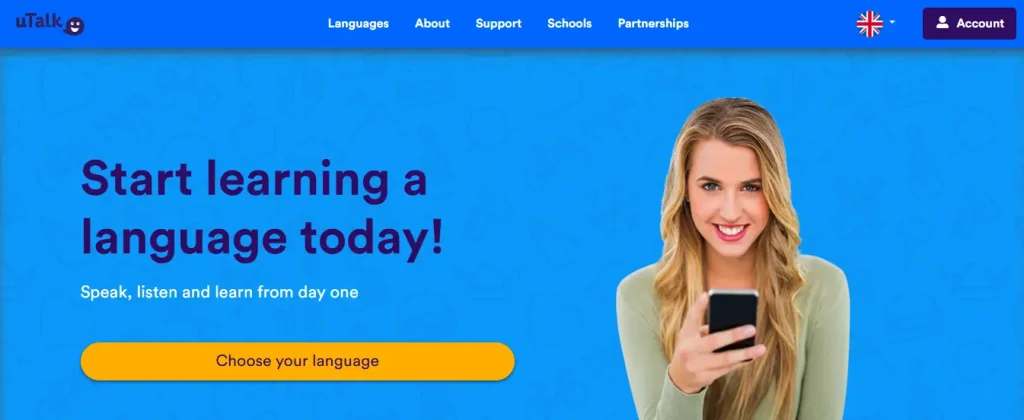
uTalk is a language learning app and platform that focuses on teaching key words and phrases in another language. It is known for its extensive library of over 150 languages, including many that are less common or endangered.
It’s perfect for beginners getting started in a language and invaluable for intermediates looking to fill in gaps in their vocabulary and pronunciation. It works for speakers of more than 100 languages.
You don’t have to be an English speaker to use uTalk. You can be a Spanish speaker who wants to learn Swahili or a Filipino speaker learning French – there are over 20,000 language learning combinations.
Pros:
- It offers a massive and diverse range of languages, from common ones like Spanish and French to more unique and endangered ones like Tok Pisin, Manx, and Yucatec Maya.
- Audio content is recorded by native speakers.
- It focuses on practical vocabulary.
- You can download content to your device, allowing you to learn a language without an internet connection.
Cons:
- Lack of grammar explanations.
- The learning is heavily based on matching words to pictures through various games.
12. FluentU
- Pricing: Premium ($29.99/mo)
- Accessibility: iOS and Android
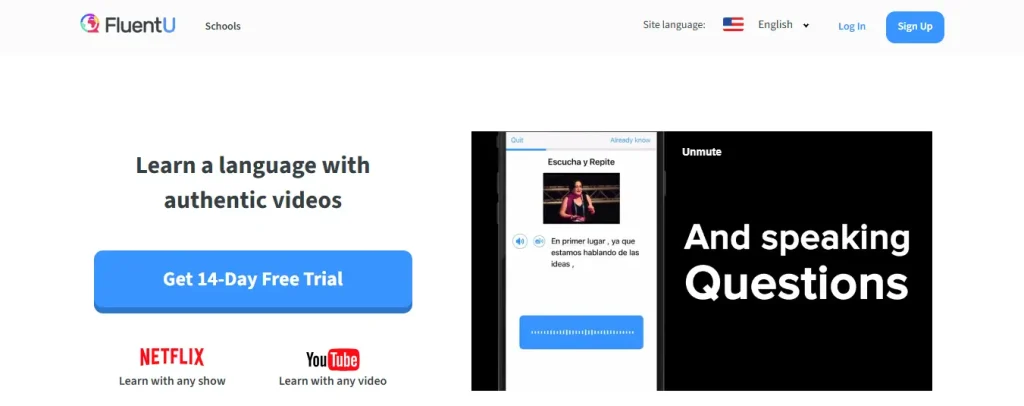
FluentU is another language learning app and platform that uses an immersive approach to help users learn a new language.
Its core method involves using authentic, real-world video content, such as movies, TV shows, and more. It has a curated library of videos that are carefully leveled – so you can easily find a video that’s just right for you.
It lets you learn with interactive captions. As you watch a video, you can click on a word to see detailed definitions, example sentences, and more. Moreover, add words to your vocabulary, and review them with a powerful learning engine.
Pros:
- It uses authentic and real-world video content to teach new languages.
- It uses immersive learning, so you learn words and phrases in context.
- The interactive subtitles provide detailed information about each word.
- With a single subscription, you get access to all the languages offered by FluentU.
Cons:
- It is often considered expensive compared to other popular languages.
- It has limited speaking practice.
- It lacks grammar explanations.
13. Lingvist
- Pricing: Monthly ($9.99/mo), Annual ($79/year)
- Accessibility: Web, iOS, and Android
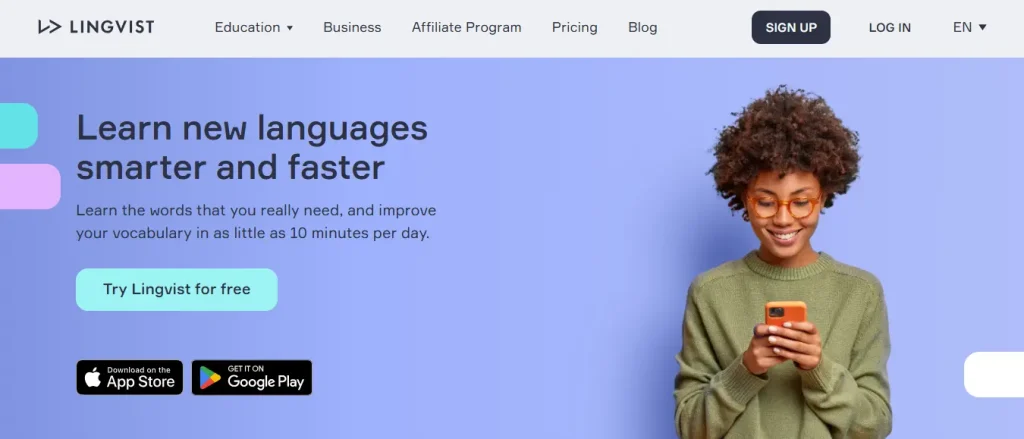
Lingvist is an AI-powered language learning app that positions itself as “the fastest way to learn languages.” It firmly focuses on vocabulary acquisition.
It supports over 50 languages, including English, Spanish, French, German, Russian, Japanese, Korean, Italian, Dutch, Portuguese, Polish, Swedish, and Danish.
It uses a spaced repetition system (SRS) and a fill-in-the-blank format to teach users the most common words and phrases in their target language.
Lingvist AI driven algorithm tracks your learning, and the system adapts to suit you so you don’t waste time studying material you already know.
Pros:
- It focuses on practical vocabulary.
- Its AI-driven algorithm tailors the lessons to your individual knowledge level and learning speed.
- Words are taught within full sentences, not in isolation.
- The app has a minimalist and user-friendly design with no ads or gamification elements.
Cons:
- Limited speaking and listening practice.
- Limited explicit grammar explanations.
- No free version.
Comparison of Duolingo Alternatives
| Apps | Pricing | Accessibility | Level | Number of Language | Best For |
|---|---|---|---|---|---|
| Babbel | Free, Single Language ($19.95/mo), All Languages ($17.95/mo), Lifetime ($299.50) | Web, iOS, and Android | Beginner – Advanced | 14 | Grammar, vocabulary, and practical conversation |
| LingoDeer | Free, Monthly ($14.99), Lifetime ($199.99) | Web, iOS, and Android | Beginner – Advanced | 20 | Learning Asian languages |
| Busuu | Free + Premium ($12.99/mo) | Web, iOS, and Android | Beginner – Advanced | 14 | Structured lessons plus real interaction with other people |
| Memrise | Free, Pro ($14.99/mo), Lifetime ($199.99) | Web, iOS, and Android | Beginner – Advanced | 30 | Vocabulary |
| LingQ | Free, Premium ($14.99/mo), Premium Plus ($29.99/mo) | Web, iOS, and Android | Intermediate | 40+ | Learning language naturally by reading and listening to authentic content |
| Drops | Free, Premium ($12.99/mo), Lifetime ($159.99) | Web, iOS, and Android | Beginner | 50+ | Vocabulary acquisition |
| Rosetta Stone | Lifetime ($219) | Web, iOS, and Android | Intermediate | 25 | Learners who want immersion and are serious about long-term fluency |
| Pimsleur | Free Lessons + Premium (Starting at $150) | Web, iOS, and Android | Intermediate | 40+ | Hands-free, audio-based learning |
| HelloTalk | Free | Web, iOS, and Android | Beginner | 180+ | Conversational practice and cultural exchange |
| italki | Vary (Marketplace) | Web, iOS, and Android | Beginner – Advanced | 150+ | Personalized guidance and structured speaking practice |
| uTalk | Premium ($11.99/mo) | Windows, Mac, iOS, and Android | Beginner | 150+ | Learning less common or endangered languages |
| FluentU | Premium ($29.99/mo) | iOS and Android | Intermediate | 10 | Learning language with authentic videos |
| Lingvist | Monthly ($9.99/mo), Annual ($79/year) | Web, iOS, and Android | Beginner – Intermediate | 50+ | Vocabulary acquisition |
Final Thoughts
Learning a new language has never been easier, as there is a wide variety of apps and platforms available today. While Duolingo is a perfect solution for beginners, it’s clear that no single app can take you all the way to fluency.
Babbel is perfect for structured grammar, Rosetta Stone for immersion, Busuu for community feedback, or italki for one-on-one lessons; the best platform depends on your personal goals and learning style.
What do you think about these Duolingo alternatives? Let me know in the comments.
Recommended Resources:

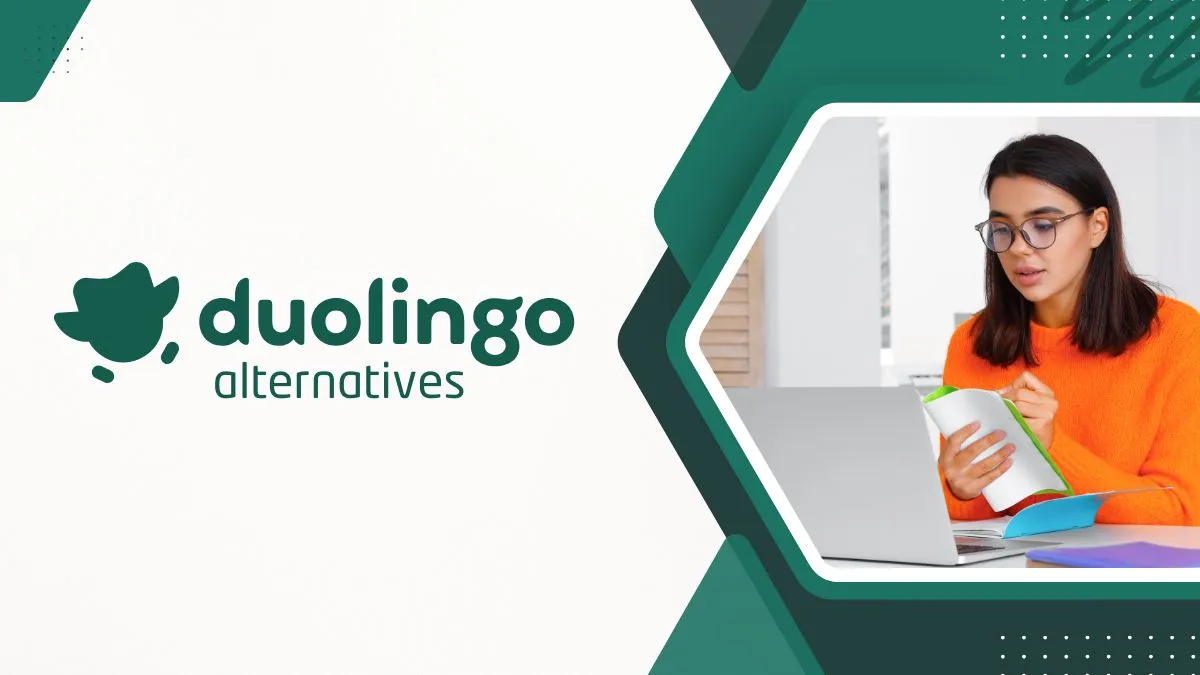
[…] 13 Best Duolingo Alternatives for Language Learning (Compared) […]